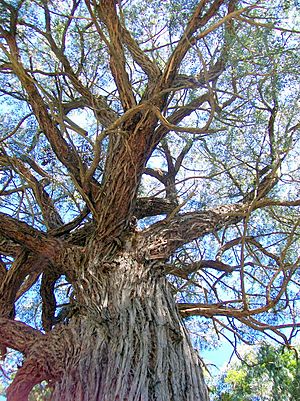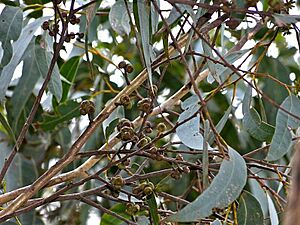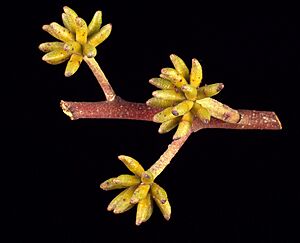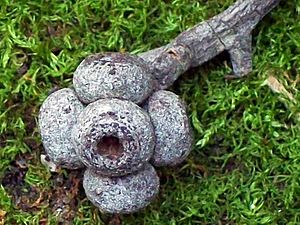Blue-leaved stringybark facts for kids
Quick facts for kids Blue-leaved stringybark |
|
|---|---|
 |
|
| Blue-leaved stringybark in Watagans National Park | |
| Scientific classification | |
| Genus: |
Eucalyptus
|
| Species: |
agglomerata
|
The Eucalyptus agglomerata, also known as the blue-leaved stringybark, is a special tree found only in eastern Australia. It's easy to spot because of its thick, stringy bark. This tree has green or greyish leaves that look a bit blue. Its flowers are white or cream-coloured and grow in groups. After the flowers, it produces small, round fruits.
Contents
What it Looks Like
The blue-leaved stringybark is a tall tree. It can grow up to 40 metres (about 130 feet) high. It has thick, stringy bark that is usually grey over a reddish-brown colour.
Young trees have green leaves that are broad and shaped like an egg. These leaves are shiny, a bit wavy, and have tiny hairs. As the tree gets older, its leaves become smooth. Adult leaves are shaped like a spear and are about 75 to 120 millimetres (3 to 5 inches) long. They are green to greyish-green and look a bit blue from a distance.
The tree's flower buds grow in groups of eleven to fifteen. These buds are oblong or spindle-shaped. They are about 7 to 8 millimetres (0.3 inches) long. The flowers themselves are white. You can usually see them blooming between October and January. After flowering, the tree produces small, flattened, round fruits. These fruits are about 3 to 5 millimetres (0.1 to 0.2 inches) long.
Tree Name and History
The Eucalyptus agglomerata was first officially described in 1922. This was done by a botanist named Joseph Maiden. He wrote about it in a science journal. The name agglomerata comes from a Latin word. It means "balled" or "gathered into a mass". This name refers to how the tree's fruits grow close together in groups.
Where it Grows
You can often find the blue-leaved stringybark on gentle slopes. It also grows on steeper slopes in the Blue Mountains. It likes different kinds of soil, but it does best in soils that hold moisture well. The soils are often made from rocks like shale and sandstone.
This tree prefers warm, humid places. It needs about 700 to 1500 millimetres (28 to 59 inches) of rain each year. In higher areas, it can handle frosts. But it doesn't like frosts in lower coastal areas. The warmest month's average temperature is usually between 25 and 31 degrees Celsius (77 to 88 degrees Fahrenheit). The coolest month's temperature is from -2 to 6 degrees Celsius (28 to 43 degrees Fahrenheit).
The blue-leaved stringybark grows within 120 kilometres (about 75 miles) of the sea. It is found in eastern central and southern New South Wales. Its range stretches north to Wauchope. It goes south into Croajingolong National Park near the Victorian border.
Koalas and the Tree
The blue-leaved stringybark is an important food source for koalas. A study in the Campbelltown area near Sydney found something interesting. Koalas liked to eat this tree's leaves. They also liked the Grey Gum tree. But they only preferred these trees when they grew on shale-based soils, not sandstone soils.
Growing This Tree
This tree is not often planted in gardens. However, it could be very useful. It can act as a great windbreak or shelter tree. This means it can help protect other plants or areas from strong winds.
Timber Uses
The wood of the blue-leaved stringybark is quite strong. Its pale brown sapwood is resistant to a type of beetle called the lyctus borer. The main part of the wood, called the heartwood, is light brown. It has a fine texture. The wood is quite heavy, weighing about 930 kilograms per cubic metre. It dries slowly. This timber is used for general building work and for making fences.
- A Field Guide to Eucalypts - Brooker & Kleinig volume 1, ISBN: 0-909605-62-9 page 67




